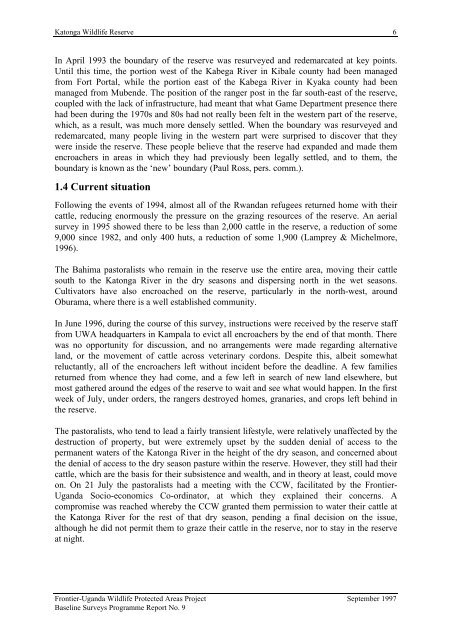Katonga Wildlife Reserve - Frontier-publications.co.uk
Katonga Wildlife Reserve - Frontier-publications.co.uk
Katonga Wildlife Reserve - Frontier-publications.co.uk
- No tags were found...
Create successful ePaper yourself
Turn your PDF publications into a flip-book with our unique Google optimized e-Paper software.
<strong>Katonga</strong> <strong>Wildlife</strong> <strong>Reserve</strong> 6In April 1993 the boundary of the reserve was resurveyed and redemarcated at key points.Until this time, the portion west of the Kabega River in Kibale <strong>co</strong>unty had been managedfrom Fort Portal, while the portion east of the Kabega River in Kyaka <strong>co</strong>unty had beenmanaged from Mubende. The position of the ranger post in the far south-east of the reserve,<strong>co</strong>upled with the lack of infrastructure, had meant that what Game Department presence therehad been during the 1970s and 80s had not really been felt in the western part of the reserve,which, as a result, was much more densely settled. When the boundary was resurveyed andredemarcated, many people living in the western part were surprised to dis<strong>co</strong>ver that theywere inside the reserve. These people believe that the reserve had expanded and made themencroachers in areas in which they had previously been legally settled, and to them, theboundary is known as the ‘new’ boundary (Paul Ross, pers. <strong>co</strong>mm.).1.4 Current situationFollowing the events of 1994, almost all of the Rwandan refugees returned home with theircattle, reducing enormously the pressure on the grazing resources of the reserve. An aerialsurvey in 1995 showed there to be less than 2,000 cattle in the reserve, a reduction of some9,000 since 1982, and only 400 huts, a reduction of some 1,900 (Lamprey & Michelmore,1996).The Bahima pastoralists who remain in the reserve use the entire area, moving their cattlesouth to the <strong>Katonga</strong> River in the dry seasons and dispersing north in the wet seasons.Cultivators have also encroached on the reserve, particularly in the north-west, aroundOburama, where there is a well established <strong>co</strong>mmunity.In June 1996, during the <strong>co</strong>urse of this survey, instructions were received by the reserve stafffrom UWA headquarters in Kampala to evict all encroachers by the end of that month. Therewas no opportunity for discussion, and no arrangements were made regarding alternativeland, or the movement of cattle across veterinary <strong>co</strong>rdons. Despite this, albeit somewhatreluctantly, all of the encroachers left without incident before the deadline. A few familiesreturned from whence they had <strong>co</strong>me, and a few left in search of new land elsewhere, butmost gathered around the edges of the reserve to wait and see what would happen. In the firstweek of July, under orders, the rangers destroyed homes, granaries, and crops left behind inthe reserve.The pastoralists, who tend to lead a fairly transient lifestyle, were relatively unaffected by thedestruction of property, but were extremely upset by the sudden denial of access to thepermanent waters of the <strong>Katonga</strong> River in the height of the dry season, and <strong>co</strong>ncerned aboutthe denial of access to the dry season pasture within the reserve. However, they still had theircattle, which are the basis for their subsistence and wealth, and in theory at least, <strong>co</strong>uld moveon. On 21 July the pastoralists had a meeting with the CCW, facilitated by the <strong>Frontier</strong>-Uganda Socio-e<strong>co</strong>nomics Co-ordinator, at which they explained their <strong>co</strong>ncerns. A<strong>co</strong>mpromise was reached whereby the CCW granted them permission to water their cattle atthe <strong>Katonga</strong> River for the rest of that dry season, pending a final decision on the issue,although he did not permit them to graze their cattle in the reserve, nor to stay in the reserveat night.<strong>Frontier</strong>-Uganda <strong>Wildlife</strong> Protected Areas Project September 1997Baseline Surveys Programme Report No. 9
















